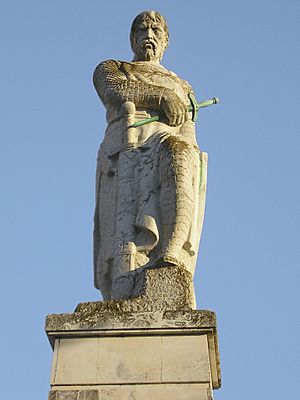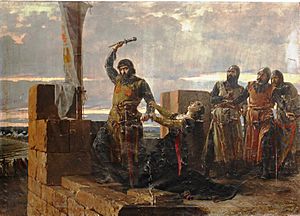Alonso Pérez de Guzmán facts for kids
Quick facts for kids
Alonso Pérez de Guzmán
|
|
|---|---|

Statue of Guzman El Bueno in Tarifa
|
|
| Born | 24 January 1256 León, Crown of Castile |
| Died | 19 September 1309 (aged 53) Gaucín, Crown of Castile |
| Allegiance | Crown of Castile |
| Battles/wars | First Siege of Gibraltar |
Alonso Pérez de Guzmán (1256–1309) was a famous Spanish nobleman and a great hero from the Middle Ages. He was known as Guzmán el Bueno (which means "Guzmán the Good"). He founded an important family line, the Dukes of Medina Sidonia.
Contents
Biography
Early Life and Background
Alonso Pérez de Guzmán was born on January 24, 1256. He was likely born in León, a city in the Crown of Castile. Some stories say he was born in Morocco.
Historians have discussed his background. Some old documents suggest he might have been from outside Spain. One document from 1297 called him a "vassal," meaning he wasn't a Spaniard.
Heroic Deeds
In 1294, King Sancho IV of Castile gave Guzmán special rights to fish for tuna. This was a reward for his brave defense of the town of Tarifa. He also built the Castle of Zahara de los Atunes and Palace of Jadraza. This was a strong castle that also had a place for people to live and process tuna.
The Defense of Tarifa
In 1296, Alonso de Guzmán bravely defended the town of Tarifa. He was in charge of Tarifa, which had recently been taken from the Moors. He defended it for King Sancho IV of Castile. This was remarkable because Guzmán had previously fought against Sancho IV. He had supported Sancho's father, Alfonso X of Castile.
Guzmán held Tarifa's castle against a siege. The attackers were the Moors and Infante Don Juan. Don Juan was King Sancho's rebellious brother.
During the siege, Don Juan held Guzmán's son captive. He threatened to kill the boy if Guzmán did not surrender the city.

According to a famous story, Guzmán refused the demand with powerful words. He reportedly said that he had not had a son for him to be used against his country. He believed his son should serve his country against its enemies. Guzmán even threw down his own knife. He told the attackers to use it to kill his son if they wished.
Rewards and Further Victories
For his brave defense of the castle, Guzmán received large areas of land from the Crown. In 1309, Guzmán helped King Ferdinand IV of Castile. They worked together to capture Gibraltar from the Moors. The Moors had controlled Gibraltar for almost 600 years, since 711.
Later, in 1445, one of Guzmán's descendants received a special title. King John II of Castile made Juan Alonzo de Guzmán the first Duke of Medina Sidonia. The nickname "El Bueno" (The Good) was used by many of his family members. This family included important leaders, generals, and colonial governors.
Legacy
- Guzmán's life has been shown in many Spanish plays. These include Guzmán el bueno. Drama en Cuatro Actos by Antonio Gil y Zárate (1840s).
- Luis Velez de Guevara (1570–1644) wrote Más pesa el Rey que la Sangre.
- Moratín Sr. (1737–1780) wrote a play about him in 1777.
- The Guzmán el Bueno metro stop in Madrid is named after him. There is also a street in Madrid where the Civil Guard barracks is located.
- Alonso appears in a play by Juan José Videgain, who is recognized as his descendant.
| Preceded by Title Created |
Señor de Sanlúcar 1297–1309 |
Succeeded by Juan Alonso Pérez de Guzmán y Coronel |
See also
 In Spanish: Guzmán el Bueno para niños
In Spanish: Guzmán el Bueno para niños
- Dukes of Medina Sidonia
- Siege of Gibraltar (1309)
Sources

